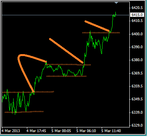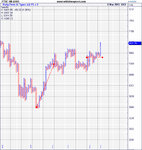Oraclefusions
Junior member
- Messages
- 47
- Likes
- 3
Chart attached.
See the horizontal support you talked about? The price did bounce off today
from the horiz support.

But i cant be using this as PF buy strategy.
On other thing.
From the point of view of candles, the stock is in range state no clear trend.
I tried different settings for 1%, i could not get a decent support line drawn.
Then i tried 2% and i have some better support. see the chart attached below. which shows the uptrend has been broken. So as per PF strategy that I use, I will wait till there is an uptrend and a double top or a double top created at the reversal of the downtrend.

See the horizontal support you talked about? The price did bounce off today
from the horiz support.

But i cant be using this as PF buy strategy.
On other thing.
From the point of view of candles, the stock is in range state no clear trend.
I tried different settings for 1%, i could not get a decent support line drawn.
Then i tried 2% and i have some better support. see the chart attached below. which shows the uptrend has been broken. So as per PF strategy that I use, I will wait till there is an uptrend and a double top or a double top created at the reversal of the downtrend.


Last edited:










